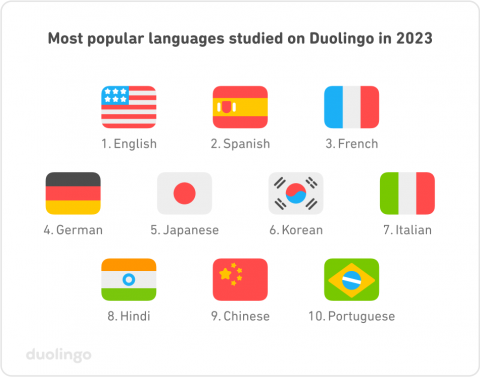2023 Duolingo Language Report
2023 language learning highlights
This year, we saw significant shuffling of the global top 10 list, generational divisions in language interests, and proof that world events continue to influence learning patterns. Let's take a look at this year's most interesting trends!
English still tops the charts
Unsurprisingly, English remains the most popular language to study around the world. This year, it was the #1 language to study in 122 countries—3 more than last year. (Afghanistan, the Maldives, and Malta joined the list!) In many parts of the world, English is important for economic and educational success, and learners in Asia are especially committed to supporting their education through English learning. In fact, a large percentage of English learners in India (40%), Vietnam (50%), and China (54%) all cite education as the primary motivation for their language study. And of our largest markets, English learners in India complete the most lessons daily.
Korean jumps in global ranking to #6
In 2023, Korean overtook Italian in the global language ranking, bringing it to #6. Korean ranks among the top 10 languages studied in some of the biggest countries around the world, including India, where it has grown 75% year-over-year.
Portuguese enters the top 10
Earlier this year, Portuguese ousted Russian for the #10 spot in the list of most popular languages. This reflects 2 major cultural changes: decreased interest in Russian in light of the war in Ukraine, and increased interest in Brazil and Portugal, especially for travelers. In fact, connecting with people (23%) and preparing for travel (18%) are the top reasons learners around the world choose to study Portuguese, and 72% of new Portuguese learners are under 30. Portuguese is also popular to study among Brazil's neighbors: It's the second-most popular to study in Bolivia, Paraguay, Uruguay, and Venezuela. In fact, Paraguay and Uruguay demonstrate the most interest in Portuguese worldwide, with around 1 in 5 Paraguyans and Uruguayans studying the language.
The war in Ukraine continues to influence language learning
Ukrainian learning has remained steady throughout most of 2023—learners see it as a way to show solidarity. Globally, 37% of new learners are studying Ukrainian to connect with people. This proportion is considerably higher than for other languages—for example, only 17% of English learners and 18% of French learners study for this reason. In 2023, the countries with the most Ukrainian learners were the U.S., the U.K., Poland, Russia, and Ukraine. Those studying Ukrainian in Australia are the most serious (based on average time spent learning), followed by those in Canada and Finland.
Ukrainians join the list of most serious learner
Belarus, Japan, Hungary, Russia, and Ukraine are home to the most serious learners in 2023. There are 2 significant changes to this list: Japan dropped to #2, and Ukraine pulled ahead to #5. These countries had the highest average time spent learning across all learners.
The generational divide: what learners study versus how they study it
Around the world, Gen Zers are picking up languages for personal reasons, whether it’s to show political solidarity or complement their interests, and this has led to a growth of interest in less commonly studied languages. For example, over half of those studying Ukrainian are Gen Z, and the growth of popular Asian languages is driven by younger learners: 86% of people studying Japanese and 76% of Chinese learners are under 30.
While younger generations are switching up what they study, older learners are setting the bar for study habits: Boomers' streaks are longer than any other generation, and even those with new streaks are less likely to break them compared to Gen Z.
Swedish is *not* the most popular language to study in Sweden
For the first time since Duolingo began collecting data, Swedish has been demoted from the top spot in Sweden! Today, the most popular language to study in Sweden is Spanish (Swedish is #2). Similarly, Danish previously ranked #2 in Denmark, but this year, the top languages in Denmark are Spanish and German.
Germany’s polyglots pull ahead of the U.K.
Last year, the countries with the largest percent of learners studying 3 or more languages were Finland and the U.K., but this year, learners in Germany pulled ahead of their British peers for the #2 spot. The U.K. could make up the difference in 2024!
Cindy Blanco

